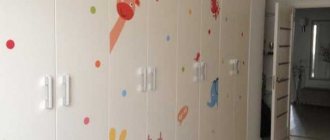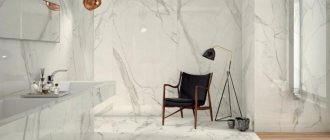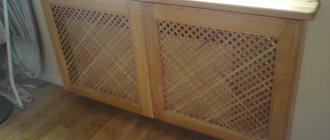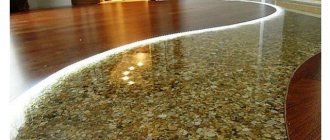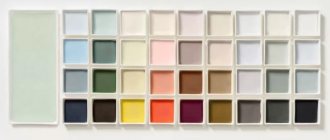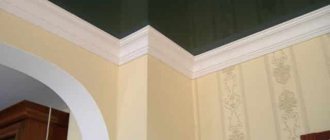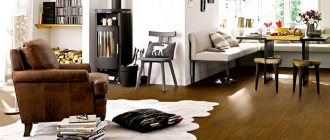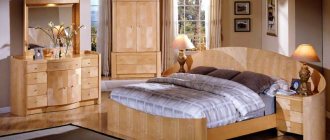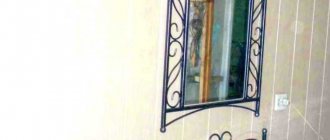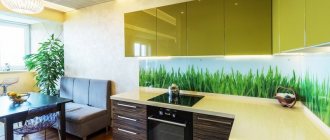What is hot stamping wallpaper?
Hot stamped wallpaper is a double-layer vinyl wallpaper.
- The bottom layer of this type of coating is based on paper or non-woven fabric.
- The base of the top is vinyl.
Under the influence of heat treatment, the top layer melts, forming a dense layer of foam. As a result, the material becomes more elastic, and is ready for the last stage - applying a drawing (pattern) using special figured rollers.
Advantages and disadvantages
Let's consider the advantages of this coating.
- Long service life. Paper wallpaper will serve you for at least 8-12 years, its non-woven counterpart - from 20 years.
- Moisture resistance. This wallpaper is “not afraid of moisture.” They can be used both when finishing the kitchen area and the corridor.
- Easy to care for. You can even use a regular kitchen sponge and dishwashing detergent to clean wallpaper. You can use a damp towel to remove any dust accumulated on the drawing.
- Resistant to direct sunlight. Hot stamped wallpaper does not fade or fade in the sun.
- Soundproofing. The non-woven fabric at the base of the covering and the porous shape of the wallpaper conceal sounds.
- Visually straighten crooked walls. A three-dimensional pattern on the wallpaper allows you to hide small unevenness on the wall.
- Quite a varied selection of textures.
Let's also pay attention to the disadvantages:
- Unresistant to mechanical stress. Due to its rough surface, the three-dimensional pattern does not “tolerate” children, animals, or children’s vehicles well.
- Artificial base. Due to the fact that vinyl is not a natural material, its quality characteristics in terms of environmental friendliness and toxicity are inferior to conventional paper wallpaper.
- The walls don't "breathe". The dense layer of vinyl in the base significantly slows down the ventilation of air between the wall and the covering, which is likely to lead to the formation of mold.
- Difficulties with gluing. Thanks to the double layer, hot-stamped wallpaper has a decent weight, which complicates the gluing process.
- Price. The price range for such coverage is quite wide. For really high-quality wallpaper you will have to pay a lot. Please note that you should not save on non-woven fabrics. However, the price of paper wallpaper fluctuates around 500 rubles. per roll.
Technology for installing embossed wallpaper on walls
As a rule, on the packaging of duplex paper wallpaper, the manufacturer indicates the type of adhesive that is suitable for use with the canvas.
Most often, this is an adhesive composition intended for heavy types of wallpaper, for example, non-woven wallpaper. Before you start gluing new wallpaper, you need to prepare the walls. To do this, old finishing materials are carefully removed from the surface, cracks, unevenness, and dirt are eliminated.
Embossed duplex wallpaper is pasted on the walls in stages:
- We treat the prepared walls with a primer to improve adhesion. Let it dry for a day.
- We check the wallpaper rolls: their batch number, shade and pattern must completely match.
- We measure the height of the walls in the room and cut the wallpaper into suitable sections. We leave allowances of 3-5 cm on each side. Carefully check that the pattern on the wallpaper matches at the joints.
- Prepare the glue and apply it to the strip using a wide brush. After this, fold the cut in a ratio of 2/3 and 1/3 and let it sit for about 10 minutes. We make sure that each canvas rests for the same amount of time.
- Draw a vertical line on the wall using a building level. This will serve as a guide for gluing the wallpaper strips.
- We glue the first strip from the window.
- Use a soft brush or rubber spatula to remove air bubbles if they have formed under the wallpaper. We do this smoothly from top to bottom and from center to edge.
- Wallpaper sheets may overlap each other slightly as they may shrink in size once they dry.
- We cut off the excess parts of the wallpaper with a construction knife.
When gluing wallpaper of this type, you should also remember a number of recommendations:
- We carry out all work at temperatures from 15 to 22 degrees Celsius.
- Avoid drafts indoors.
- If glue gets on the outer surface of the canvas, remove it with a soft sponge, gently blotting it, but not rubbing it.
- If the wallpaper has a pattern, then it is best to glue them together, but if you don’t need to join the pattern, then you can do it yourself.
- It is not necessary to remove sockets and switches when wallpapering walls. It is enough to turn off the power to the room and remove the covers. The wallpaper must first be applied to the surface of the wall and a cut in the shape of a cross must be made.
Hot and cold embossed wallpaper on a non-woven base are glued in the same way.
It is worth noting that non-woven fabric is a transparent material. Therefore, if the top layer of wallpaper is not too thick, then a non-uniform layer of paint on the walls or seams in the gypsum plasterboard can be visible through it. Before gluing this type of embossed wallpaper, you need to hold it against the wall in sunlight and make sure that the uneven color does not show through the canvas. If wall defects are visible, then you will have to additionally prepare the surface - paint it in one tone. However, if you plan to paint wallpaper, then you don’t have to paint the walls.
For non-woven wallpaper, you need to use a thick glue that does not turn yellow after it dries. We carry out wallpapering work according to the following instructions:
- We cut the wallpaper into strips according to the height of the walls plus 5-7 cm. Remember that the pattern or design must match.
- Apply glue to the wall with a brush or roller. The width of the treated surface should slightly exceed the width of the wallpaper cut.
- We apply the dry canvas to the wall and press it.
- Using a rubber brush or soft rag, remove the air that has accumulated under the wallpaper.
- We glue the strips of this wallpaper end to end, leaving no gaps or overlaps.
Remember that it is best to glue wallpaper in a room with a uniform temperature. Hot radiators or drafts of cold wind from windows will negatively affect the appearance of the finishing material after drying.
Types of hot stamping wallpaper
Among the many options for this coating, the following varieties can be distinguished.
- Silkscreen printing . This coating is quite thin, which is explained by a small layer of polyvinyl chloride. Silk-screen printing allows you to create a three-dimensional effect due to silk fabric and shimmer with sparkles. However, it is suitable for a room with perfectly smooth walls.
- Contact vinyl . The exact opposite of silk-screen printing - the vinyl layer is quite thick, which adds significant weight to the coating. Contact vinyl has a relief structure, thanks to which it can imitate brick, fabric, leather and other natural materials.
- Double layer vinyl (heavy vinyl) . Much denser than contact vinyl and has a pronounced pattern.
- Chemical embossing. A special agent, inhibitors, is applied to the vinyl layer along the outline of the pattern, resulting in the formation of a three-dimensional pattern on the wallpaper.
Embossed wallpaper manufacturing technology
Embossed wallpaper has this name due to the special technology of its production. Depending on the base material used to create this type of wallpaper, hot, dry, wet, or chemical embossing is used to produce a relief pattern.
Embossed (relief) wallpaper is made using the following technology:
- Intaglio printing. This method makes it possible to transfer the most subtle transitions of color and shades onto the canvas, creating the illusion of a real image.
- Paper laminating. The inner layer of wallpaper is glued to the top layer with a special adhesive.
- Embossing. Wet glued wallpaper passes through a steel and paper shaft. The profile of the upper steel shaft has a pattern that is transferred in the form of texture to the canvas.
- Drying finished wallpaper, cutting, forming rolls.
Thanks to this manufacturing technology, wallpaper of this type is considered the most stable, that is, it has minimal stretch when wetted with glue.
In addition, this is a very durable wallpaper. Embossed wallpaper can be made not only on paper, but also on a non-woven base. Polyvinyl chloride treatment can be used, which significantly improves the performance characteristics of the wallpaper.
Color palette
Hot stamping wallpaper is rich in textures and patterns. For example, contact vinyl is more often used as an imitation of natural materials - wood, leather, brick.
In turn, among the colors of heavy vinyl, bright shades predominate. Iridescent silk-screen printing is characterized by bed pastel colors, sophisticated patterns, and monograms.
Read about fashion trends in wallpaper for walls here -
Gluing process
In the process of covering walls, it is important to consider several points. Firstly, it is the heavy weight of the wallpaper (in the case of contact vinyl and heavy vinyl). Secondly, you need to glue joint to joint, especially if there is a pattern on the wallpaper.
Please note that the success of covering vinyl wallpaper directly depends on the preliminary preparation of the wall: it must be dry and clean. Before gluing, it is advisable to remove the baseboard, switches and sockets. Always start gluing from the corner. Cut off excess pieces with a well-sharpened tool.
Preparing a wall for a “duplex”
Walls require careful preparation before gluing paper wallpaper. It is especially relevant for “heavy” types, which, after drying, can peel off whole canvases along with untreated strengthening primer putty, old whitewash or not completely removed old wallpaper.
Despite the significant thickness and the ability to mask small irregularities and defects in the walls, it is not worth making “spot” repairs - covering up only large flaws: cracks, chips, seams between slabs, saving putty. In the remaining areas there may be peeling plaster or putty that is not visible to the eye, but has peeled off. Especially dangerous are long-term layers of whitewash (paint) and old wallpaper, which peel off after getting wet and create air bubbles or folds on the wallpaper. These are the areas where heavy wallpaper peels off.
After repairing the defects - rubbing with putty and after drying - treating with an abrasive mesh, be sure to putty on the entire surface of the walls with a thin layer (1-2 mm).
Allow the putty to dry for at least 24 hours. After this, use an abrasive mesh to remove the putty deposits remaining from the spatula, sweep the surface with a broom or brush and treat it twice with a primer. The best option is a deep penetration acrylic primer. But you can use the glue that you will use to glue the wallpaper, diluted in the proportion indicated on the package. Usually 1:5.
Allow the primer to dry completely, otherwise the effect of the treatment will not be noticeable. The walls will still be moisture permeable.
The best manufacturers
One of the leaders in the production of hot-stamped wallpaper is Germany, namely such companies as AS Creation, Rasch and Erismann.
Italy is practically not inferior to its European neighbor - the Zambaiti and Sirpi brands are worthy competitors in the world market.
The Ukrainian factory "Eden" produces vinyl wallpaper of European quality.
Among domestic manufacturers you can find “Erisman”, “Elysium”.
In the interior of different rooms
Hot stamping wallpaper is perfect for the design of any room. For example, pastel colors of silk-screen printing will decorate the bedroom, and patterns and monograms will add tenderness and sophistication to the room. However, dark compact vinyl will provide a more relaxed atmosphere in the room.
The nursery and kitchen will be decorated with bright colors such as yellow, green, pink, turquoise, blue. However, it is better to combine several shades. For the kitchen, you can also use imitation stone or brickwork.
In the living room, the best option would be a predominance of metallic tones, which in turn will give the room a sense of conceptuality and spaciousness. Stylized furniture is an ideal complement.
Learn more about wallpaper for the living room.
Varieties
There are several different popular solutions that are produced using the hot stamping method. They (with some exceptions) have fairly similar technical characteristics, but the appearance is usually quite different.
The combination of black and white will create a high-quality interior
- The first type is silk-screen printing, which produces a coating that resembles silk (although it is not). A special luminescent coating reflects light in a unique way, so when illuminated, a room with such wallpaper looks unique. The color range is quite limited, and the relief is not very textured, but resembles silk.
- The thickest variety is the so-called “compact vinyl”. This same variety is one of the most common. Such vinyl wallpapers weigh a lot, their texture is deep and very embossed, and the palette is the richest; you can find hundreds of shades of colors, which will allow you to ideally choose the optimal solution specifically for your interior. The texture of compact vinyl can be stylized, for example, imitating wood, brick or even leather - therefore, if you want to adhere to a certain direction in interior design, compact vinyl will come in handy.
- Inhibited vinyl is a type of compact vinyl, but processed slightly differently. Chemical embossing is also added to the manufacturing process of the latter, which adds unique characteristics to this coating. Therefore, the price of this variety is one of the highest.
Related article: DIY decorative vases
Increased texture of vinyl wallpaper
Photo collection
A few more gluing options that you can do at home.
